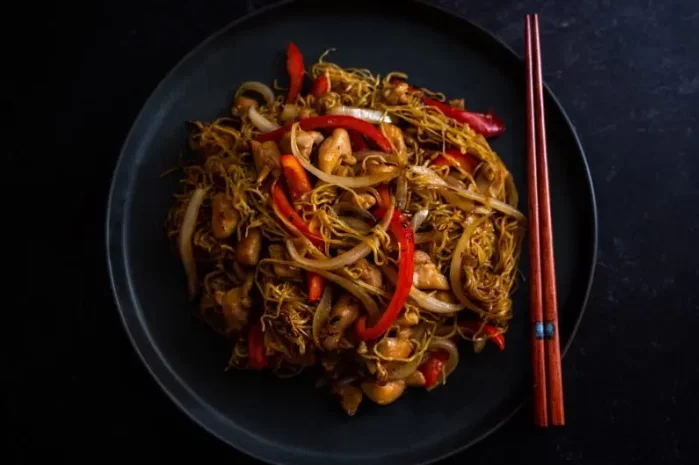Asian brown sauce is a versatile, flavorful condiment used in many Asian dishes, especially in Chinese cuisine. It’s commonly used to enhance the taste of stir-fries, meats, vegetables, and noodles. This sauce is known for its rich umami flavor, which comes from a mix of ingredients like soy sauce, oyster sauce, and various seasonings. The beauty of this sauce is that it’s easy to make at home with simple ingredients, and you can adjust the taste to suit your preference.
In this article, we will walk you through the process of making traditional Asian brown sauce. We will also explore variations of the sauce, as well as the key ingredients that contribute to its delicious flavor.
What is Asian Brown Sauce?
Asian brown sauce, also known as Chinese brown sauce, is a savory, slightly sweet sauce that is typically used in stir-fries, braised dishes, and as a dipping sauce. Its base is usually made from soy sauce, oyster sauce, and other flavor enhancers like garlic, ginger, and cornstarch. The combination of salty, sweet, and umami flavors creates a sauce that can elevate a wide variety of dishes.
The sauce is often served with dishes that have meat, such as chicken, beef, or pork, and vegetables, like broccoli, bell peppers, and mushrooms. It is particularly popular in Chinese-American takeout dishes, such as beef and broccoli, chicken with mixed vegetables, or sweet and sour chicken.
Key Ingredients for Asian Brown Sauce
Making Asian brown sauce at home is easy when you have the right ingredients. While there are several variations, the following ingredients are essential for the basic version of the sauce:
Soy Sauce: The main source of saltiness and umami flavor. You can use light soy sauce for a milder taste or dark soy sauce for a richer, slightly sweeter flavor. If you’re looking for a gluten-free version, tamari is a great substitute.
Oyster Sauce: A thick, savory sauce made from oyster extracts. It provides depth of flavor and a slight sweetness to the sauce. If you prefer a vegetarian version, you can use mushroom oyster sauce as a substitute.
Chicken Broth or Water: This helps to dilute the sauce to the right consistency. Chicken broth adds extra flavor, but you can use vegetable broth or water for a lighter taste.
Sugar: Usually white sugar or brown sugar, it balances the savory components of the sauce with a touch of sweetness. Brown sugar adds a bit more depth and complexity.
Cornstarch: This ingredient helps to thicken the sauce and gives it that glossy, smooth texture. Cornstarch mixed with water forms a slurry, which you add to the sauce towards the end of cooking to thicken it.
Ginger and Garlic: These aromatics bring fresh, zesty flavors to the sauce. Fresh ginger is preferred for its bright, pungent flavor, while garlic adds a savory depth.
Sesame Oil: A small amount of sesame oil provides a toasty, nutty aroma and flavor to the sauce.
Rice Vinegar: A little splash of rice vinegar adds acidity and helps balance out the richness of the sauce.
Step-by-Step Guide to Making Asian Brown Sauce
Now that you know the essential ingredients, let’s break down the process of making Asian brown sauce.
1. Prepare the Ingredients
Before you start cooking, gather all the necessary ingredients and equipment. You will need a small saucepan, a whisk, and a measuring cup or spoons to ensure accuracy.
Measure the Soy Sauce: You’ll need about 1/4 cup of soy sauce as the base of the sauce.
Prepare the Broth: Measure 1/2 cup of chicken broth or water. This will help dilute the soy sauce and create the right consistency.
Slice the Ginger and Garlic: Peel and finely chop 1 teaspoon of fresh ginger and 2-3 garlic cloves.
2. Heat the Saucepan
Place a small saucepan on medium heat. Add 1-2 teaspoons of vegetable oil to the pan and heat it up. Once the oil is hot, add the chopped garlic and ginger. Sauté them for about 1-2 minutes until fragrant. Be careful not to burn the garlic, as it can turn bitter.
3. Add the Soy Sauce and Oyster Sauce
Next, pour in the soy sauce (1/4 cup) and the oyster sauce (2 tablespoons). Stir the mixture well to combine the two sauces. The soy sauce will provide saltiness, while the oyster sauce will add depth and a slight sweetness to the sauce.
4. Add Broth and Sugar
Add the chicken broth (1/2 cup) to the pan. Stir the mixture to dissolve the sauces into the broth. Then, add about 1 tablespoon of sugar. You can use white sugar, but brown sugar gives the sauce a richer, more complex flavor.
5. Simmer and Mix
Bring the sauce to a simmer over medium heat. Allow the mixture to simmer for 3-4 minutes, stirring occasionally, so that the flavors have time to blend together. During this time, the sauce will reduce slightly and become more concentrated.
6. Thicken the Sauce with Cornstarch Slurry
To thicken the sauce, you’ll need to make a cornstarch slurry. In a small bowl, mix 1 tablespoon of cornstarch with 2 tablespoons of cold water. Stir until the cornstarch is fully dissolved.
Slowly pour the cornstarch slurry into the simmering sauce while continuously stirring. The sauce will begin to thicken almost immediately. Keep stirring for another 1-2 minutes, until the sauce has reached your desired consistency. If it gets too thick, you can add a bit more broth or water to thin it out.
7. Add Flavor Enhancers
To finish off the sauce, add 1 teaspoon of sesame oil for a rich, nutty flavor. You can also add a small splash of rice vinegar (about 1 teaspoon) to balance the sweetness and add some acidity.
8. Taste and Adjust
Taste the sauce and adjust the seasoning as needed. If you prefer a sweeter sauce, add a bit more sugar. If you like it saltier, add a touch more soy sauce. You can also add more vinegar for extra tang or more sesame oil for a deeper, nutty flavor.
9. Serve
Once your sauce is perfect, it’s ready to serve! Pour it over stir-fried vegetables, meat, or noodles. You can also store the sauce in an airtight container in the refrigerator for up to a week.
Variations of Asian Brown Sauce
While the basic recipe is delicious, there are many ways to customize your Asian brown sauce to suit different dishes or personal preferences. Here are a few variations to consider:
1. Spicy Brown Sauce
For those who like a bit of heat, add chili paste, red pepper flakes, or sriracha sauce to your brown sauce. Start with 1/2 teaspoon of chili paste and increase the amount to your preferred spice level.
2. Vegetarian Brown Sauce
To make a vegetarian or vegan version of brown sauce, simply replace the oyster sauce with mushroom oyster sauce or hoisin sauce. These sauces provide similar depth and sweetness, but without the use of seafood.
3. Ginger-Orange Brown Sauce
For a refreshing twist, you can add a tablespoon of fresh orange juice and zest along with the ginger and garlic. The citrusy notes complement the savory flavors and add brightness to the sauce.
4. Garlic Brown Sauce
If you love garlic, increase the garlic to 4-5 cloves. You can even add garlic powder or garlic oil for a more intense garlic flavor.
5. Honey Brown Sauce
For a slightly sweeter version of brown sauce, swap out the sugar for honey. Honey will add a more natural sweetness and pair wonderfully with stir-fried meats and vegetables.
Tips for Making the Best Asian Brown Sauce
Use High-Quality Soy Sauce: The flavor of soy sauce can vary greatly between brands. Opt for a high-quality soy sauce, preferably one that is brewed naturally, for the best flavor.
Don’t Overcook the Garlic: Garlic burns quickly and can turn bitter. Sauté it gently until fragrant, and avoid browning it.
Control the Thickness: You can always adjust the thickness of your sauce by adding more or less cornstarch slurry. If it’s too thin, make another batch of cornstarch slurry and add it slowly.
Store Leftovers Properly: If you have leftover sauce, store it in a sealed container in the fridge. It will keep for up to a week, and you can easily reheat it when needed.
Conclusion
Making Asian brown sauce at home is quick and simple, and it adds a wonderful depth of flavor to a variety of dishes. By using a combination of soy sauce, oyster sauce, and a few seasonings, you can create a rich, savory sauce that pairs well with vegetables, meats, and noodles. Experiment with different variations to tailor the sauce to your taste, and enjoy its versatility in your cooking.
Now that you know how to make Asian brown sauce, you can elevate your home-cooked meals with this delicious, homemade condiment. Happy cooking!
Related topics:























